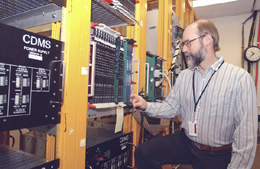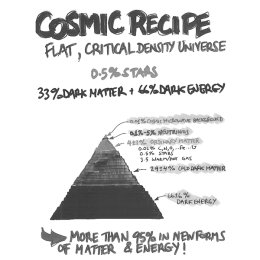 |
|
How to Catch a Cold Wimp 'Serious' refrigeration the key to Cryogenic Dark Matter Search by Pamela Zerbinos It is relatively well-established, as far as these things go, that the vast majority of the universe is unaccounted for. It’s not “missing,” per se — we know where it is. We just don’t know what it is. We can’t see it, except by the effects it has on matter, such as galaxies, that we can see (much as we can “see” wind by watching the trees sway). But help is on the way. After almost a year of difficulties, scientists working on the Cryogenic Dark Matter Search say they’re nearly ready to begin the second stage of their search for the dark matter candidate known as the “WIMP,”or Weakly Interacting Massive Particle. “There’s a lot of crazy stuff going on out in the universe if you try to understand it,” said Fermilab’s Michael Crisler, who handles the electronics for CDMS. “But [WIMPs] are a compelling model. They provide a nice, tight, uniform explanation for a lot of things, and tie together all the gravitational anomalies.” “WIMP” is actually a generic name for a group of as-yet-undiscovered heavy particles that interact only through the weak force. One group of WIMPs known as supersymmetric particles looks particularly promising, and the lightest SUSY particle, the neutralino, is currently the leading dark matter candidate. Another SUSY particle, the axion, also has its proponents, and there are additional theories espousing extremely heavy particles called WIMPzillas, others proposing sterile neutrinos, and some who say that maybe we don’t know as much about gravity as we think we do.
Sorting through all these theories and particles may seem daunting, but at a recent cosmology conference in Chicago, most scientists seemed confident they would be able to pin down dark matter within the decade. CDMS will play a major role in this undertaking; if WIMPs exist, they are firmly in the experiment’s crosshairs. The upcoming phase of the experiment will take place in Minnesota’s Soudan Mine, half a mile underground to shield the detectors from interfering cosmic rays. The detector towers contain six individual detectors made of silicon or germanium, and are about the size of a beer can. The first tower destined for Soudan has been running for the past year at Stanford, and moving the tower to Soudan, a much deeper site, will significantly reduce the cosmic ray background and therefore enhance the physics results this tower produces. When a WIMP hits a germanium nucleus in one of the detectors, the nucleus will recoil and cause the entire germanium crystal to vibrate. The vibrations will pass to the surface of the crystal, where they will heat up thin aluminum traps connected by tungsten. The tungsten is held at a critical temperature, and by monitoring changes in its temperature, CDMS scientists will be able to track the passage of WIMPs through their detectors. “Everybody has a very high confidence level,” Crisler said.“But I’m sure you wouldn’t find anyone who, for fear of jinxing it, would say that it’s working.” The “it” in question is a quantum-mechanical refrigerator, which keeps the tungsten at that critical temperature, around 70 millikelvins — “seriously cold,” Crisler said, and the detectors themselves are even colder. It is a $200,000 machine made by Oxford Instruments that bubbles helium 3 through helium 4 and is more commonly known as a dilution refrigerator. The refrigerator was purchased several years ago with money from Stanford, and then “it sat in a crate for a while,” Crisler said.“Problems weren’t anticipated. We started off assuming that we’d just buy this thing and it ’d work.” Fermilab’s Roger Dixon, who was the CDMS project manager at the time, recalled trying to cool the refrigerator down in the summer of 2001.
“We ran into a lot of minor problems at first,” Dixon said,“and then we got to the point where we were able to cool it down all the way, around the first of the year. That’s when we discovered two potentially serious problems.” The first, and most serious, was a superfluid leak that only showed itself when the refrigerator was very cold — under a few degrees Kelvin. The second was a bit of weld bead that was preventing two flanges from mating properly, resulting in an intermittent leak from the helium bath into the outer insulating vacuum. “That’s the unglamorous reality of it,” said Crisler.“A dilution refrigerator doesn’t have any moving parts. It’s just a bunch of plumbing. So if you have a problem, it’s either an obstruction or a leak. “The plumbing is extremely delicate and small in places; it’s a very subtle object. It goes through a fairly extensive set of tests, and was demonstrated to be working in the factory. It came here, and it can spring leaks during the shipping and handling process. And there’s a certain amount of disassembly and reassembly that has to take place to hook up our stuff to it. At any step along the way, something could fail. And if one thing fails anywhere in the system, the dilution refrigerator experts can usually pin it down and fix it. Our problem was that we had two things fail that created a set of symptoms so complicated that the best of our experts were completely foiled until they took it apart so that they got one problem over here and one problem over there and they could pin it down.” It took a lot of hard work, but fortunately, both problems eventually were pinned down and fixed. “They finally got very aggressive and took the thing completely apart,” Crisler said. Now that it’s back together and seems to be working properly, scientists expect to begin testing the ice box by itself in early December (the ice box is the cryostat in which the detectors live while they’re detecting). Meanwhile, CDMS has a new project manager, Dan Bauer, who is in charge of scheduling and budget issues, as well as of keeping track of the experiment’s technical progress. Bauer, who has been with CDMS since 1995, served as the operations coordinator for the first phase of the experiment, CDMS I, at Stanford, and has been the integration coordinator for CDMS II. He relocated to Fermilab from the University of California at Santa Barbara in early September of this year to take over the reins from Dixon. Bauer was a graduate student at Fermilab in the ’70s, which is why he was able to reclaim his original, low ID number (04383), something he says everyone keeps asking him about. Dixon has been appointed head of Beams Division, but plans to keep working with CDMS. As for the experimenters, they hope to have at least one detector tower, possibly two, installed in the ice box in early 2003. After a few months of commissioning and calibration, the detectors should be up and running by summer. They’ll collect data for about a year, and the final three towers (for a total of 30 individual detectors) should be installed by spring of 2004 to run through the end of 2005. “Of course, all that could change depending on what we see in the first year,” Bauer said. “We should be able to get a much better idea of where the experiment should go in that time — or, if we’re lucky, we’ll discover dark matter.”
ON THE WEB: CDMS Homepage: http://cdms.berkeley.edu/ CDMS at Fermilab: http://ppd.fnal.gov/experiments/cdms/ |

